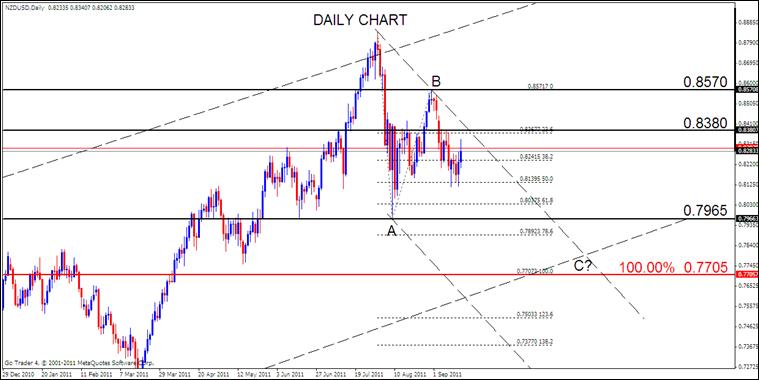U.S. Dollar. Our bias NEUTRAL, on the sidelines till a clearer picture develops.
FUNDAMENTALS: The focus last week for markets has been on Europe but this will change in the coming week with theFederal Reserve gearing up for one of the most important FOMC meetings in along time. For the past month and a half, Fed Chairman Ben Bernanke has been subtly hinting to the market that easier monetary policy is on the way. When the FOMC last met on August 9th, they pledged to keep interest rates at exceptionally low levels through at least until mid 2013. By stating a time frame for how long rates will remain low, the Fed clearly wanted to make sure everyone realized how committed they are to keeping monetary policy easy. The minutes from the meeting revealed deep discussions about alternative ways to stimulate the U.S. economy which suggests that it is no longer a matter of if, but only a matter of when the Federal Reserve will make another attempt to jumpstart the U.S. economy. The pessimistic tone of the FOMC minutes also made it clear that policymakers are warming to the idea of more Quantative Easing (QE). Considering that a few members sought stronger action immediately and central bank officials openly discussed different ways to stimulate the economy, itappears the Federal Reserve just needed more time to weigh the cost and benefits of each policy tool. They will have an opportunity to do so this week with policymakers spending 2 full days on September 20th/21st, discussing options and market participants will be looking for not only words, but also action at the conclusion of this meeting.
With the U.S. economy showing zero employment and retail sales growth for the month of August, the decisions reached at this weeks meeting are expected to be significant. If reserved rhetoric is delivered (e.g. no further stimulus) investors will punish the Fed by liquidating out of risky assets, making financial and economic conditions even worse. However, by preparing the market for more stimulus given Bernankes recent comments, the Federal Reserve has also given investors an opportunity to discount a move, which means if the central bank wants a substantial, positive reaction from the markets, they may need to go above and beyond what investors already expect. The most likely options for the Fed are:
1) Promising to not reduce their securities portfolio until 2013
2) Funding the purchase of long term Treasuries with the sale of short term ones (“Operation Twist”)
3) Lowering the interest rate on reserves.
4) Announcing another round of asset purchases
The first option would be far too inadequate to satisfy investors as all talk and no action means nothing. Operation Twist has been talked about extensively as the option the Fed will choose to stimulate the economy but the problem is that it hasalready been priced in and may elicit nothing more than a weak response by the market, therefore wasting the Fed’s efforts. The same is true for lowering the interest rate on reserves. So if the Fed wants to surprise themarket and trigger a sharp rally in currencies and equities, they will need to be more aggressive. As economists talk about the risk of another recession,current global financial conditions call for desperate measures and that may mean throwing everything at the U.S. economy including the kitchen sink. Although this would be short term bearish for the U.S. Dollar, it could help it significantly over the longerterm.
TECHNICALS: The Dollar Index has exceeded its May high at 9,763 but reversed. Price is testing support from the August high but the more important level is 38.2% retracement at 9,650. This level is reinforced by an Elliott channel this week. The implications are for weakness into 9,650 before price reverses and heads to a new high. Given the market moving Fed rate decision and policy announcement on Wednesday, we will remain on the sidelines with the Greenback until a clearer picture emerges.
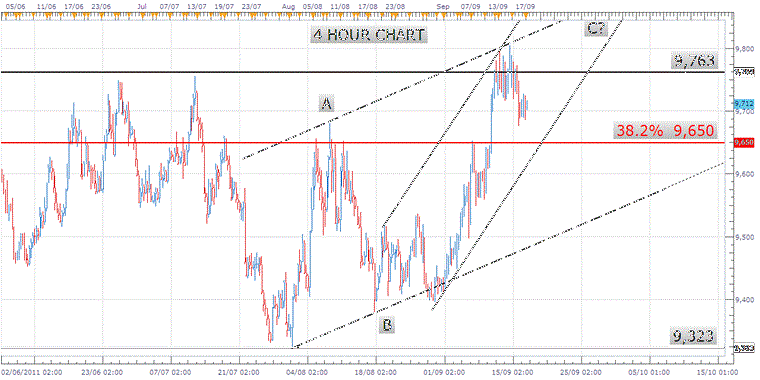
Euro. Our bias BEARISH, we’ll be looking to sell on rallies
FUNDAMENTALS: After rallying for four straight trading days last week, the Euro weakened against the U.S Dollar in Fridays trading sessions. ECOFIN meetings of European Finance Ministers were held over the weekend and it would seem that U.S. Treasury Secretary Geithner’s attendance has backfired for the U.S. with European officials criticizing the U.S. for telling them what they should do when they cannot even get their own house in order. Germany remains opposed to Euro-bonds and the decision to release the next much needed tranche of aid to Greece has been delayed until October. The decision to delay the aid suggests that Germany and France may not be as“behind Greece” as they would like the world to believe. If Greece does not receive further bailout funds by mid-October, they will have effectively run out of money and the possibility of default becomes a reality. Adding complications to the Greek governments’ problem, less than 75% of private sector creditors agreed to participate in the country’s buy-back program, which was far less than the 90% they had anticipated. The shortfall will have to be filled by official support from other nations and the insufficiency has not gone overwell with EURUSD investors. Aside from this weeks FOMC meeting and outcome of the weekend ECOFIN meeting, market participants will be watching for comments from Moody’s who has finished their 3 month review of Italy’s sovereign debt rating. Given Italian Prime Minister Berlusconi’s decision to water down the country’s austerity program, a credit downgrade or at least a warning could be forthcoming. In the week ahead, significant Euro data will include the German ZEW survey on Tuesday along with the advance September PMI numbers on Thursday. Further deterioration in the readings are expected due to the slowdown in economic global growth which means the Euro could remain under pressure this week.
TECHNICALS: Notably, other USD patterns (the AUDUSD and DOLLAR INDEX in particular) still imply U.S.Dollarstrength so EURUSD gains from the current levels are dubious. However, a drop to a new low could complete the break from the triangle and decline from 1.4550. The February low at 1.3430 is of particular interest and as such weremain Euro bearish in the week ahead.
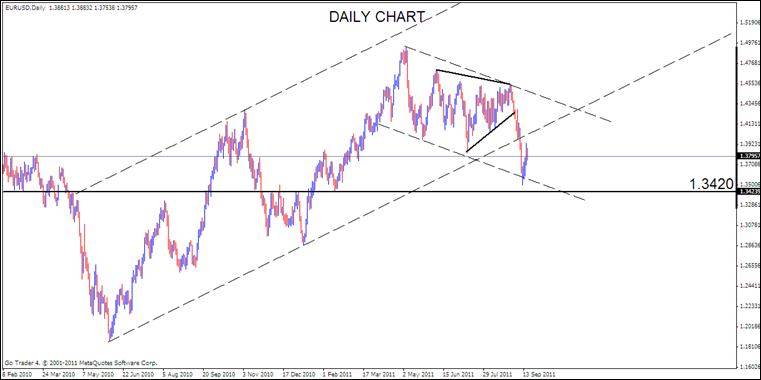
Japanese Yen. Our bias NEUTRAL, on the sidelines till a clearer picture develops.
FUNDAMENTALS: It has been a mixed week for the Japanese Yen which traded sideways against the Euro and Swiss Franc but weakened against all of the other major currencies as 76.00 continues to be rock solid support for USDJPY with investors worrying about the possibility of Bank of Japan intervention. There were reports last week that the BoJ could be checking rates but with USDJPY not seeing any fresh moves to the downside, the central bank held off on further intervention. However, this may not be enough for the general populous. The Japanese ruling party called on the Finance Ministry and the Bank of Japan to strengthen their ties and work together to address the Yen’s rise. They want the central bank to ease monetary policy appropriately and to establish a fund to address the problems caused by the Yen’s rise. The Cabinet is scheduled to release their monthly economic report this week and it will be noteworthy to see if their sentiment has changed. This week economic calendar sees leading indicators, department store sales, and the trade balance scheduled for release. Although these numbers are important in gauging the overall health of the Japanese economy, the Yen will take its cue from the result of Tues/Weds FOMC meeting.
TECHNICALS: The rally from the record low at 75.95 is corrective and price has broken its short term trendline support. Thursday’s spike reversed at the 61.8% retracement of the decline from 77.85, which points lower for USDJPY, however, we remain on the sidelines for the Yen until theoutcome of Wednesdays FOMC meeting.
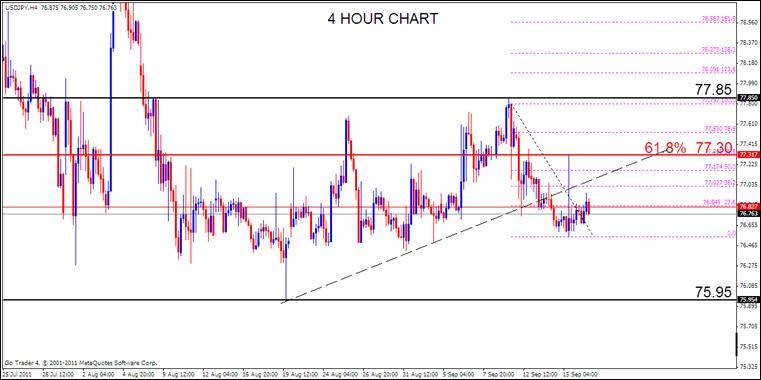
British Pound. Our bias BEARISH, we’ll be looking to sell on rallies
FUNDAMENTALS: Last week, Sterling price action was centred on EURGBP and not GBPUSD. While the Pound fluctuated within a 180 pip range against the U.S. Dollar, the Euro fell to a 6 month low against the Pound, taking the EURGBP cross below 0.8550. However, the sell-off was short-lived with the currency pair bouncing back towards 0.8800 over the next 3 trading days. Despite the abundance of market moving U.K. data last week, the volatility in EURGBP can be blamed entirely on the Euro. U.K. economic reports showed both weakness and recovery in the U.K. economy. Consumer spending declined, but not as severely as economists had feared while the number of people filing for jobless benefits rose by the smallest amount in 3 months. U.K. officials continued to talk about the need for more stimulus, but so far there is little clarity on how ready and willing they are to implement this. It was only recently that the two monetary policy committee members who had previously voted for a rate hike switched camps and since then, economic data has beenchoppy. This week’s BoE minutes will provide more information on just how close the central bank is to increasing asset purchases, with most analystssaying the MPC will not be pulling the trigger anytime soon. Bank of England member Bean said inflation is expected to come down next year, but right now, consumer prices still remain well above the central bank’s target. In theweek ahead, aside from the MPC minutes, public sector finances, consumer confidence and the CBI Total Trends survey are the only numbers scheduled for release. This means that in all likelihood, Sterling will continue to take its cue from U.S. and Euro-zone developments.
TECHNICALS: Cable is currently testing the 12th July low at 1.5780 and additional weakness would target the 100% extension level at 1.5660. We remain bearish Sterling in the week ahead and would look to sell any rallies into the 1.5900 area.
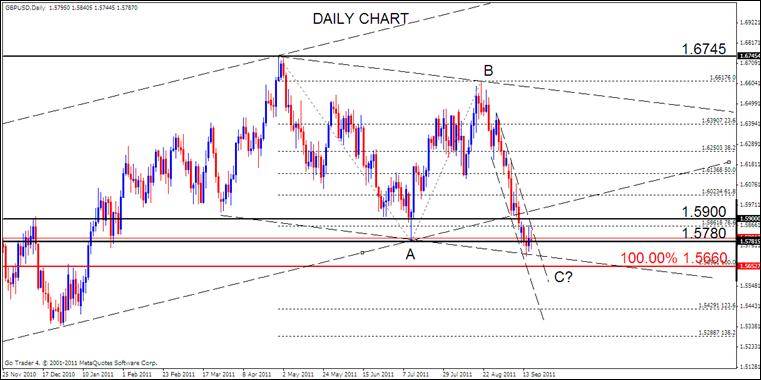
Canadian Dollar. Our bias BEARISH, we’ll be looking to sell on rallies
FUNDAMENTALS: The Loonie gained against the U.S. Dollar last week as USDCAD dropped some 200 odd pips from its Monday open to its close on Friday. Although the improvement in risk appetite can be credited for part of the move, the real reason was profit taking on long Dollar positions. With the Federal Reserve gearing up to announce more stimulus this week, the U.S. Dollar stands to suffer and the currencies whose central banks are the mostwilling to raise interest rates or leave them steady stand to benefit. This is why the Canadian Dollar proved to be a big beneficiary of asset allocation out of U.S. Dollars. The latest International Securities Transactions report showed foreign purchases of Canadian Dollar denominatedassets rose C$11.78B which included a record C$5.91B of federal money market paper purchases. This came as foreigners sold US$36.5B worth of short term U.S. securities. The Loonie will remain in focus for investors this week with CPI, leading indicators and retail sales all scheduled for release.
TECHNICALS: USDCAD has found support at the 200 SMA and 38.2% fib retracement of the 27th July-9th August rally. Additional weakness is expected to below 0.9725 levels before the pair stages yet another reversal and as such, we remain Loonie bearish in the week ahead.

Australian Dollar. Our bias BEARISH, we’ll be looking to sell on rallies
FUNDAMENTALS: Last week, as the Dow Jones Industrial Average rallied by 4.70%, the Aussie fell by 1.00% against the U.S. Dollar. This suggests that equity markets are entirely too bullish and are due for a retracement while the technicals are pointing towards further AUDUSD losses. The week ahead will unlikely provide any relief for the Aussie, at least on a fundamental basis. The minutes from the Reserve Bank of Australia meeting on September 6th are due on Tuesday. At the meeting, the Board of the Reserve Bank of Australia voted to leave the cash rate unchanged at 4.75%. RBA Governor Glenn Stevens noted that “conditions in global financial markets have been very unsettled overrecent weeks and as a result, the outlook for the global economy is less clear than it was earlier in the year.” Governor Stevens’ statement included a note that some “temporary impediments to growth, such as the supply-chain disruptions from the Japanese earthquake as well as higher commodity prices, were lessening.” The statement afterwards also suggested that “employment has been moderate this year, while CPI inflation should start to decline” Given these observations, it appears that the RBA is becoming increasingly dovish. While concerns over the Australian economy are limited in scope, any pullback in Australian growth is likely to be provoked by broader global macro-economic trends. This has translated into a weaker Australian Dollar over the third quarter of 2011, as interest rate expectations have deteriorated sharply inrecent weeks. This sentiment will likely be confirmed in the minutes from the meeting, and with any future rate hikes essentially off the table at this point, it will take a significant upturn in broader global macro-economic indicators to fuel the risk rally and thus boost the Aussie.
TECHNICALS: AUDUSD has found resistance at the 1.0400 level, which isdefined by the 200 SMA and Tuesday 13th high. If an impulse is underway from the 1.0765 high, then 1.0480 should not be breached on a daily close basis. As such we remain Aussie bearish in the week ahead.
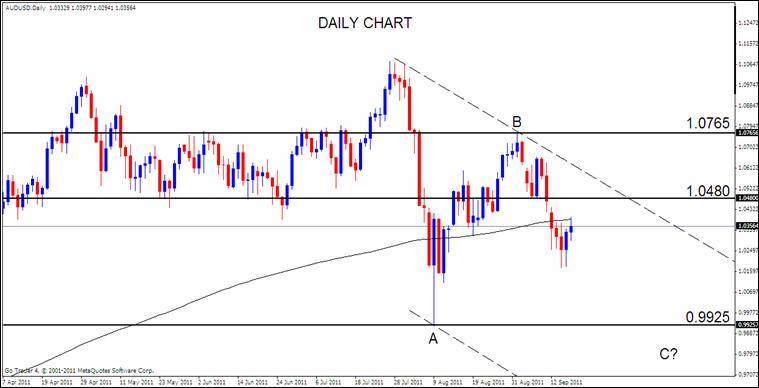
New Zealand Dollar. Our bias NEUTRAL, on the sidelines till a clearer picture develops.
FUNDAMENTALS: Last week, the Reserve Bank of New Zealand curbed its outlook for future growth as the marked appreciation in the Kiwi dampens the prospects for exporters, and saw the “risk of global growth slowing sharply” after holding the benchmark interest rate at 2.50%. At the same time, RBNZ Governor Alan Bollard talked down the risk for inflation, stating that “the strength in the kiwi has helped to insulate the economy from imported price growth”, but went onto say that borrowing costs “will need to increase should the slowdown in global growth have a mild impact on the New Zealand economy”. Despite the dovish comments from the RBNZ, market participants still see the central bank restoring the interest rate back to 3.00% over the next 12-months according to Credit Suisse Overnight Index Swaps. The week ahead sees current account and GDP reports due on Tuesday and Thursday, however, these reports will likely take a back seat as market participants focus on the result of the mid-week Fed meeting.
TECHNICALS: Focus is now on the 6th September high at 0.8380 and the trendline that extends off of the August highs that would be resistance. Rallies to this area would present selling opportunities; however, we will stay on the sidelines with this pair until after Wednesdays’ FOMC meeting.
